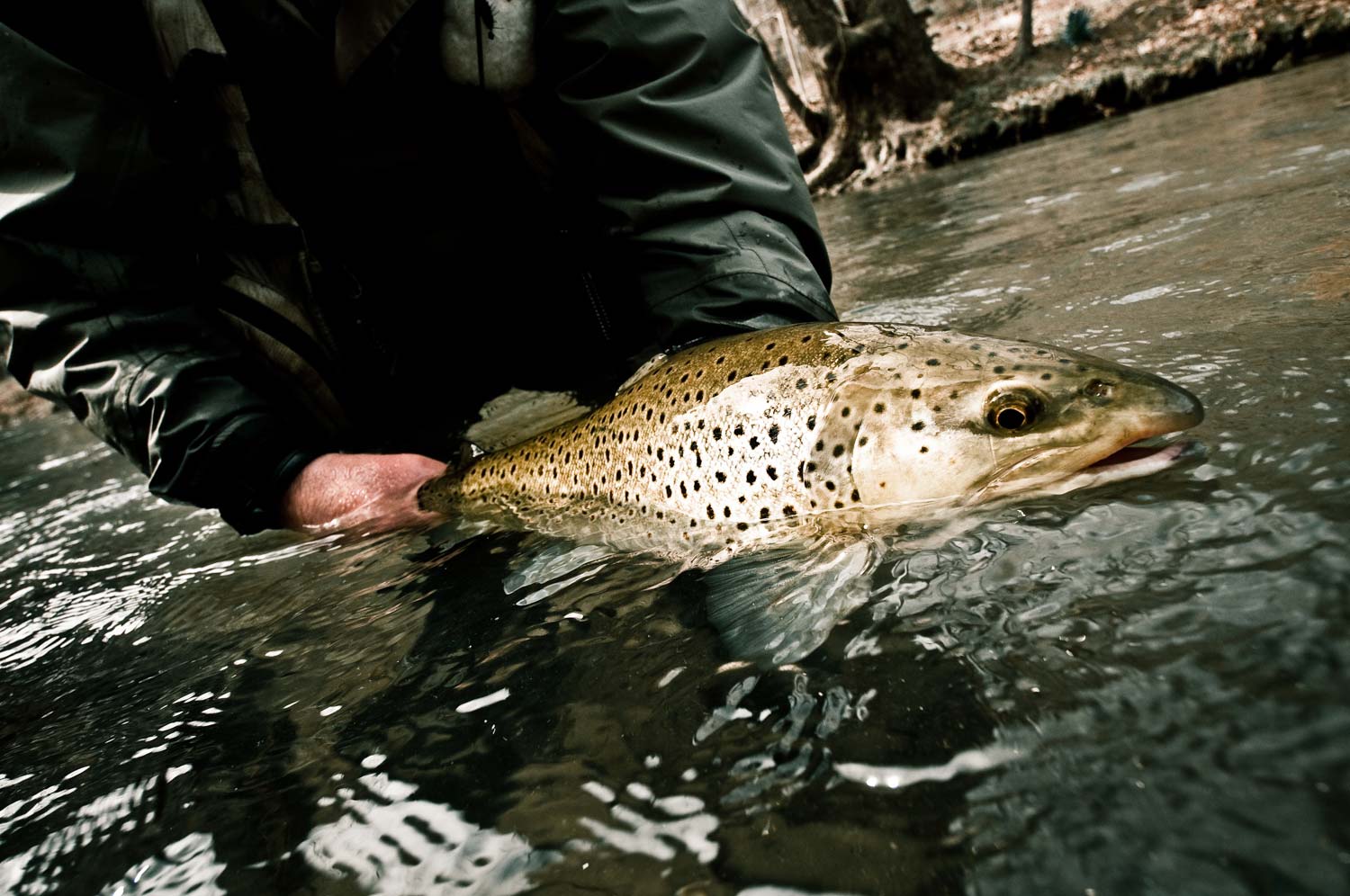
By Jason Tucker
Small stream fishing often conjures to mind light rods and lines, small dry flies, an easy, pleasant day on the creek casting to small trout.
It indeed can be that, and most of my small stream fishing consists of this. But I firmly believe every small stream out there holds bigger fish, and more of them, than you think. One of the best ways to find out is with streamers.
Researchers have shown that as brown trout reach the twenty-inch mark they become largely piscivorous (fish eating). This means if you want to catch them, you need to throw streamers.
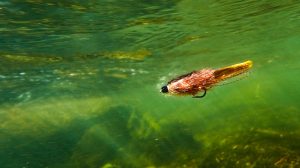 Streamer fishing has changed a lot since the days of hair wing flies and Grey Ghosts. If you have fly fished for any amount of time you have heard of or read “Modern Streamers for Trophy Trout” by Kelly Galloup and Bob Linsenman. Streamer enthusiasts today pound the banks with articulated monsters measuring five to as much as twelve inches long. This is great for bigger rivers but a bit of overkill for small streams. You’ll want to scale your efforts to the water you’re fishing. Still, streamer fishing small streams can be a very enjoyable way to fish them, and a great way to find out the true potential of the stream.
Streamer fishing has changed a lot since the days of hair wing flies and Grey Ghosts. If you have fly fished for any amount of time you have heard of or read “Modern Streamers for Trophy Trout” by Kelly Galloup and Bob Linsenman. Streamer enthusiasts today pound the banks with articulated monsters measuring five to as much as twelve inches long. This is great for bigger rivers but a bit of overkill for small streams. You’ll want to scale your efforts to the water you’re fishing. Still, streamer fishing small streams can be a very enjoyable way to fish them, and a great way to find out the true potential of the stream.
My streamer box for small streams contains the following:
Muddler Minnow size 4-10
Cone Head Madonna/Zuddler size 4 in barred yellow, olive, black and white
Black Dace size 6-10
Mickey Finn size 6-10
Zoo Cougars size 6 in yellow and white
As I said I try to scale my streamers to the water I’m fishing. It would be rare for me to tie on a size two streamer. Most of the forage fish in a stream are going to be closer to the size of traditional hair-wing streamers like Mickey Finns and black-nosed dace. In a lot of small stream situations, I prefer the stealthier presentation of hair-wing streamers to the loud splat of bigger, heavier streamers advocated in “Modern Streamers”. Trout in small streams are well aware of everything going on in the water. That splat can be what sends them on the run.
By far my favorite streamer for small streams is a Muddler Minnow.
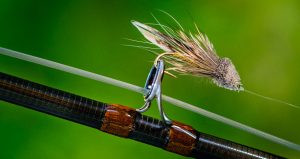 It is a great sculpin imitator, and all the streams I fish both North and South are chock full of them. Trout eat them with abandon. Even big fish will roll out for a size eight Muddler. If you want an enjoyable day seeing and catching lots of fish, tie on a Muddler minnow and go to town. I find that original versions work better than marabou or conehead versions. Sculpins hug the bottom normally, and when trout see a muddler swimming up high, they think something is wrong, triggering a response. That’s my theory and I’m sticking with it.
It is a great sculpin imitator, and all the streams I fish both North and South are chock full of them. Trout eat them with abandon. Even big fish will roll out for a size eight Muddler. If you want an enjoyable day seeing and catching lots of fish, tie on a Muddler minnow and go to town. I find that original versions work better than marabou or conehead versions. Sculpins hug the bottom normally, and when trout see a muddler swimming up high, they think something is wrong, triggering a response. That’s my theory and I’m sticking with it.
My second choice is the conehead Madonna, which to my untrained eye is nearly identical to a Zuddler. It’s another sculpin stand-in; a great pattern with lots of action and a good profile. It has some “plop” to it, but not so much that it will spook fish in normal or high-water situations, and it’s a great pattern for finding bigger fish in the system.
After that I like the Mickey Finn and black-nosed dace. They are tried and true classic patterns that brook trout especially go for. Black-nosed dace are forage minnows, and very common in small streams. The yellow and red of Mickey Finns is also very effective. I always try to keep these in my box.
Lastly, if I suspect that water holds bigger fish, I’ll tie on a zoo cougar. Their disadvantage is that they’ll float even when saturated. Because of that you need a sink-tip, or a split shot a foot above it. For that to work you need enough room in the water to allow it to sink, work it, and hopefully get a reaction. If the stream is too small you may not even get the streamer down before it’s out of the hole. But on the right piece of small stream you may see a fish following that scares you.
There are dozens of other great streamer patterns out there, from marabou streamers to various flash minnows to woolly bugger variations. If you have a favorite, take it out and give it a try. These are just my go-to patterns, and I try to keep things simple.
Presentation
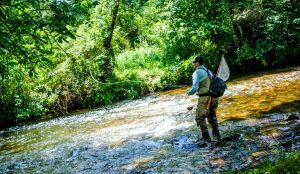 Fishing all flies revolves around three words- presentation, presentation, and presentation. It’s no less true with streamers, though finesse has a different definition when throwing them. On large streams the game is pounding banks and cover, usually while drifting downstream on the front of a drift boat. On small streams, you’re typically wading upstream picking small spots apart. Sometimes your only shot is directly upstream, fishing your streamer back to you. You do your best to fish close to cover, but in some water that’s your only choice. I look for woody debris and cut banks. Grass banks are almost always undercut. In the South I like rock walls next to deep water and deep plunge pools. A lot of times the fish will prefer a streamer swimming sideways to the current, so if you can get your streamer even a little across the current it helps. If you throw an upstream mend then retrieve just faster than the current you can achieve this.
Fishing all flies revolves around three words- presentation, presentation, and presentation. It’s no less true with streamers, though finesse has a different definition when throwing them. On large streams the game is pounding banks and cover, usually while drifting downstream on the front of a drift boat. On small streams, you’re typically wading upstream picking small spots apart. Sometimes your only shot is directly upstream, fishing your streamer back to you. You do your best to fish close to cover, but in some water that’s your only choice. I look for woody debris and cut banks. Grass banks are almost always undercut. In the South I like rock walls next to deep water and deep plunge pools. A lot of times the fish will prefer a streamer swimming sideways to the current, so if you can get your streamer even a little across the current it helps. If you throw an upstream mend then retrieve just faster than the current you can achieve this.
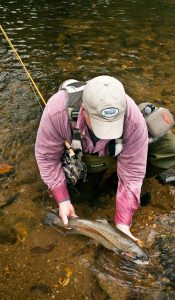 I’m always using a short leader, three to for feet long in the eight to twelve pound range. This seems to help them sink faster if you’re using a sink tip; getting it down to the level of the fish quickly is paramount. Some streams are so small that a sink tip is undesirable and unnecessary. If the stream is small enough or the water low and clear, the sound of that sink tip hitting the water will spook every fish around. The same with using larger, weighted streamers. If you’re not catching fish or see you are spooking them then switch to hair-wing flies and present them gently.
I’m always using a short leader, three to for feet long in the eight to twelve pound range. This seems to help them sink faster if you’re using a sink tip; getting it down to the level of the fish quickly is paramount. Some streams are so small that a sink tip is undesirable and unnecessary. If the stream is small enough or the water low and clear, the sound of that sink tip hitting the water will spook every fish around. The same with using larger, weighted streamers. If you’re not catching fish or see you are spooking them then switch to hair-wing flies and present them gently.
Lastly, put as much action into your streamers as you can. Long strips won’t produce a lot of action. Rapid short strips with some twitches of the rod tip will get fish interested. I’m trying to get as much action out of my fly while keeping it in the zone. Muddlers especially you will want to fish as twitchy as possible.
If all you want from small stream fishing is a quiet day casting dry flies that’s fine. It’s certainly how I spend most of my days. If you want a change of pace and see the true potential of the stream, bring that streamer box, tie one on, and see what happens.
Jason writes the fine blog Fontinalis Rising
Jason Tucker
Gink & Gasoline www.ginkandgasoline.com hookups@ginkandgasoline.com Sign Up For Our Weekly Newsletter!
Great article! Last year I learned exactly what you are describing here.
My buddy and our kids have camped on a small Sierra stream for 4 or 5 years now. Last summer, while bringing in a standard 5″-6″ rainbow I saw a dark shadow easily twice that size take a shot at my fish.
I quickly tied on the only streamer I had with me (2 to 3 inches long that I use for Calico Bass in saltwater) and I caught that big fish and a number of others that weekend.
Super fun!
great read, as always JT. Miss having you in Michigan. Let me know if you get back up here and want to float. Gotta add the ever effective Zonker and clouser.
Tight Lines,
Koz
Great article. One question – I get my best action out of a streamer when I strip it and jiggle the rod tip. However, this often means putting an angle in the line from the rod tip to the fly. Now, when & if I get a strike, I’ve lost “straight line” contact with the fly, and the rod tip absorbs a lot of the force needed for a positive hook set. Other than sharper hooks, any suggestions?